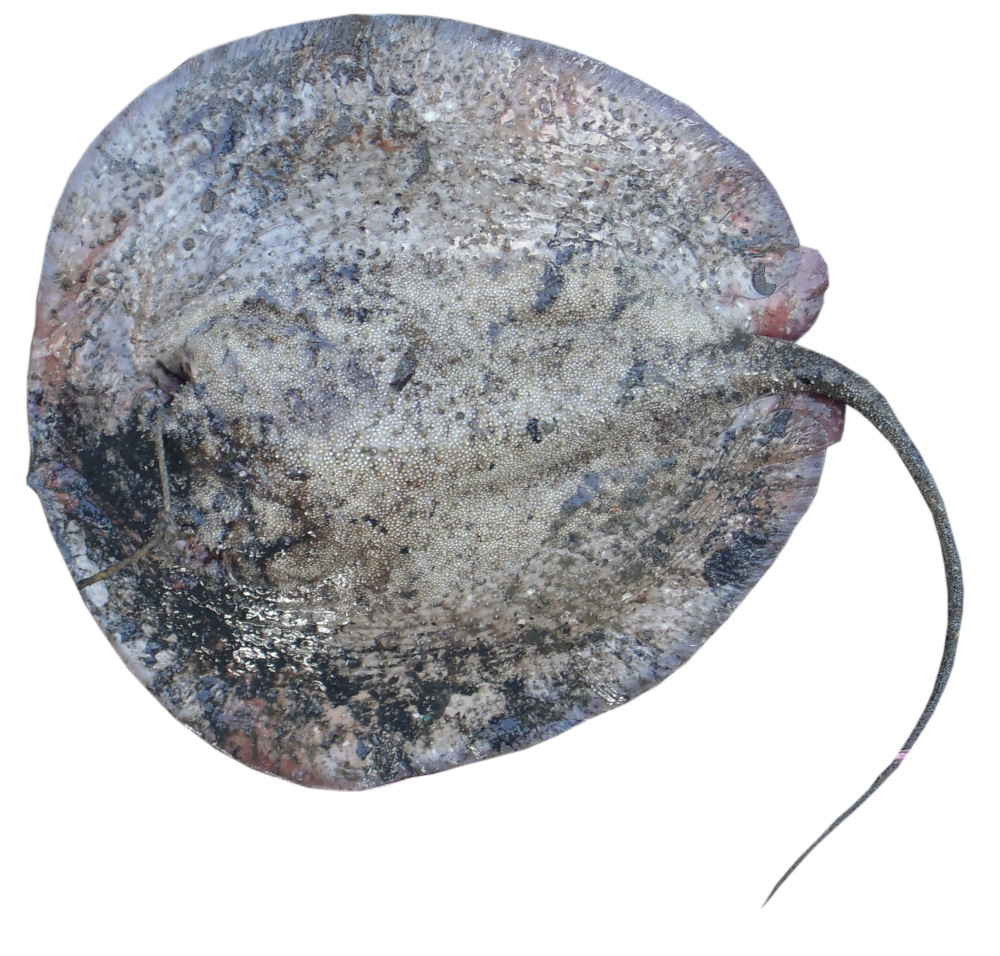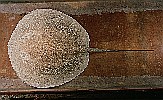Urogymnus asperrimus
(Bloch & Schneider, 1801)
Porcupine ray
Classification: Elasmobranchii Myliobatiformes Dasyatidae
Reference of the original description
M.E. Blochii Systema Ichthyologiae iconibus ex illustratum. Post obitum auctoris opus inchoatum absolvit, correxit, interpolavit. J.G. Schneider, Saxo: 584 p., 110 pl.
M.E. Blochii Systema Ichthyologiae iconibus ex illustratum. Post obitum auctoris opus inchoatum absolvit, correxit, interpolavit. J.G. Schneider, Saxo: 584 p., 110 pl.
Image of the original description
No image in first description.
No image in first description.
Synonyms / new combinations and misspellings
Anacanthus africanus, Anacanthus asperrimus, Raja africana*, Raja asperrima, Rhachinotus africanus, Urogymnus africana, Urogymnus africanus, Urogymnus aperrimus, Urogymnus asperatus, Urogymnus asperrimus solanderi, Urogymnus rhombeus
Anacanthus africanus, Anacanthus asperrimus, Raja africana*, Raja asperrima, Rhachinotus africanus, Urogymnus africana, Urogymnus africanus, Urogymnus aperrimus, Urogymnus asperatus, Urogymnus asperrimus solanderi, Urogymnus rhombeus
Types
Urogymnus asperrimus
Holotype: ZMB: 7836
Anacanthus asperrimus
XXXX: No types known;
Raja africana*
Holotype: ZMB: 7837
Urogymnus asperrimus solanderi
Holotype: QM: I.1112 QM: I.1113 QM: I.1114
Urogymnus rhombeus
Syntype: SMNS: 1630; ZMB: 10864
Urogymnus asperrimus
Holotype: ZMB: 7836
Anacanthus asperrimus
XXXX: No types known;
Raja africana*
Holotype: ZMB: 7837
Urogymnus asperrimus solanderi
Holotype: QM: I.1112 QM: I.1113 QM: I.1114
Urogymnus rhombeus
Syntype: SMNS: 1630; ZMB: 10864
Description :
Citation: Urogymnus asperrimus (Bloch & Schneider, 1801): In: Database of modern sharks, rays and chimaeras, www.shark-references.com, World Wide Web electronic publication, Version 12/2025
Please send your images of "Urogymnus asperrimus" to info@shark-references.com

Urogymnus asperrimus (Bloch & Schneider, 1801), female, 76 cm DW, landed at Junglighat landing center, India © K. K. Bineesh, India

Urogymnus asperrimus (Bloch & Schneider, 1801), female, 76 cm DW, landed at Junglighat landing center, India © K. K. Bineesh, India
Common names
 Raya africana,
Raya africana,  Pastenague sans dard,
Pastenague sans dard,  Black spotted ray,
Black spotted ray,  Porcupine ray,
Porcupine ray,  Porcupineray,
Porcupineray,  Rough-skinned ray,
Rough-skinned ray,  Roughskin stingaree,
Roughskin stingaree,  Solanders ray,
Solanders ray,  Thorny ray,
Thorny ray,  Thorny-ray,
Thorny-ray,  Raia pungente africana
Raia pungente africana
 Raya africana,
Raya africana,  Pastenague sans dard,
Pastenague sans dard,  Black spotted ray,
Black spotted ray,  Porcupine ray,
Porcupine ray,  Porcupineray,
Porcupineray,  Rough-skinned ray,
Rough-skinned ray,  Roughskin stingaree,
Roughskin stingaree,  Solanders ray,
Solanders ray,  Thorny ray,
Thorny ray,  Thorny-ray,
Thorny-ray,  Raia pungente africana
Raia pungente africana
Short Description
A heavily armored stingray lacking a venomous barb; young with large, flat denticles on upper surface, and large juveniles and adults with additional sharp conical thorns and small, pointed denticles [536]. Very thick elongated disc with broadly rounded outer corners; snout broadly rounded and tail slender, about as long as body and without finfolds [536]. Light grey or whitish dorsally, white ventrally; tail blackish [536].
A heavily armored stingray lacking a venomous barb; young with large, flat denticles on upper surface, and large juveniles and adults with additional sharp conical thorns and small, pointed denticles [536]. Very thick elongated disc with broadly rounded outer corners; snout broadly rounded and tail slender, about as long as body and without finfolds [536]. Light grey or whitish dorsally, white ventrally; tail blackish [536].
Distribution
Indo-Pacific: Red Sea and coast of East Africa to the Marshall Islands and Fiji, south to northern Australia [17644]. Eastern Atlantic: Senegal, Guinea, and Côte d"quot;Ivoire (Ref. 4438). Source: www.gbif.org
Indo-Pacific: Red Sea and coast of East Africa to the Marshall Islands and Fiji, south to northern Australia [17644]. Eastern Atlantic: Senegal, Guinea, and Côte d"quot;Ivoire (Ref. 4438). Source: www.gbif.org
Human uses
fisheries: commercial
fisheries: commercial
Biology
Exhibit ovoviparity (aplacental viviparity), with embryos feeding initially on yolk, then receiving additional nourishment from the mother by indirect absorption of uterine fluid enriched with mucus, fat or protein through specialised structures [733]. Distinct pairing with embrace [17086]. Distinct pairing with embrace [17086].
Exhibit ovoviparity (aplacental viviparity), with embryos feeding initially on yolk, then receiving additional nourishment from the mother by indirect absorption of uterine fluid enriched with mucus, fat or protein through specialised structures [733]. Distinct pairing with embrace [17086]. Distinct pairing with embrace [17086].
Habitat
reef-associated; brackish; marine
reef-associated; brackish; marine
Remarks
shark-references Species-ID=7407;
shark-references Species-ID=7407;
Parasites (arranged by Jürgen Pollerspöck)
Monogenea
Cestoda
Nematoda
Hirudinea
Monogenea
- Dendromonocotyle pipinna Chisholm & Whittington, 2004 [7386]
- Dendromonocotyle urogymni Chisholm & Whittington, 2009 [8717]
- Neoentobdella baggioi Whittington & Kearn, 2009 [9458]
Cestoda
- Acanthobothrium coronatum (Rudolphi, 1819) Van Beneden, 1850 [16448]
- Acanthobothrium urogymni (Hornell, 1912) Baer & Euzet, 1962 [16175] [28741]
- Phyllobothrium lintoni (Southwell, 1912) [26667] [16443]
- Phyllobothrium pammicrum Shipley & Hornell, 1906 [16412] [16443]
- Pillersium owenium Southwell, 1927 [16410]
- Prochristianella butlerae Beveridge, 1990 [17404]
- Rhinebothrium devaneyi Brooks & Deardorff, 1988 [7609]
- Tetragonocephalum sp. [23959] [31429]
Nematoda
Hirudinea


















